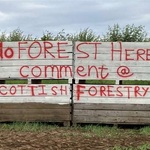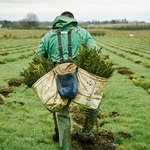
17th September 2023 - By Jack Haugh Deputy Editor - forestryjournal.co.uk
FORESTRY bosses have moved to reassure angry locals that plans to transform disused farmland into a commercial woodland will be "carefully considered".
Treeline Forestry is proposing to plant a mix of Sitka and other conifer trees on around 200 hectares of farmland in Aberdeenshire.
The new commercial woodland – west of Rhynie – is proposed to help deliver a sustainable supply of wood and wood fibre to local markets. Those behind the plans say the new forest will also help the Scottish Government meet its net zero carbon emissions targets to tackle climate change.
However, almost 500 people signed an online petition to stop the project. The Mains of Rhynie Action Group (MRAG) was set up to fight the “woodland creation”. Despite their opposition to the plans, they stress they are not against planting trees — but against planting “wrong trees in the wrong place for all the wrong reasons”. However, almost 500 people signed an online petition to stop the project. The Mains of Rhynie Action Group (MRAG) was set up to fight the “woodland creation”. Despite their opposition to the plans, they stress they are not against planting trees — but against planting “wrong trees in the wrong place for all the wrong reasons”.
Treeline Forestry has applied to the Scottish Government’s Forestry Grant Scheme, which encourages farmers and landowners to “maximise underproductive land” by creating woodlands.
Responding to the concerns of locals, a Scottish Forestry spokesperson stressed that every proposed woodland is “subject to rigorous assessment” and consulting with local communities is a key part of the application process.
The applicant’s proposals were placed on the Public Register for comment and the deadline was extended to give people more time for feedback. The consultation period ended on July 21, and the application is still being considered.
“At this stage, we have taken no decision or expressed a view on the project,” the spokesperson said.
“Expanding Scotland’s woodlands and forests is vital if we are to tackle the twin crises of climate change and nature loss. For this reason, Scotland has the most ambitious woodland creation targets in the UK.
“Under our role as the Scottish Government’s forestry regulator, every new proposed woodland project is subject to rigorous assessment against the high benchmarks set by the UK Forestry Standard.
“It is important to note that all woodland projects are required to include a percentage of native woodland in their schemes and we are committed to ensuring the right trees are planted in the right place.”

Since 2015, Scotland has planted over 185,300 acres of new woodland. According to the spokesman, if it all had been planted on farmland, it would still be less than 2% of the total agricultural land in the country.
The spokesperson added: “Forestry and farming can and do exist together and we can achieve our woodland creation targets without the need to plant on prime agricultural land. As part of the approval process for Mains of Rhynie we will be taking all this into account when taking a decision on the current application.”
Treeline Forestry was approached for comment, but in the Forestry Grant Scheme application stated: "The main goal of this proposal is to create a new multi-benefit, multifunctional woodland that will help to deliver a sustainable supply of roundwood and wood fibre to local markets.
"Additional benefits also include helping Scottish Government to meet its net zero carbon emissions targets by sequestering carbon through the growing of trees.
"The planting of conifers is intended to provide a sustainable supply of roundwood and wood fibre during development and eventually to provide a strategic productive timber source of good quality material to help satisfy the high demand in the domestic, industrial and international markets, with a high proportion of the material being received by local markets within Aberdeenshire.
"The new woodland proposal focuses on productive species rather than native species to make better use of the ground and growing medium for trees."



